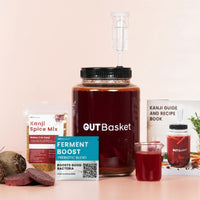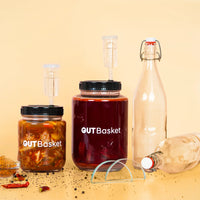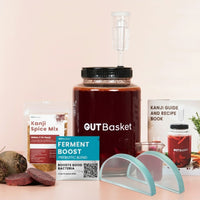Pomegranate wine is a delightful blend of sweet and tangy flavors, capturing the essence of this ruby-red fruit in every sip. With its vibrant color and rich taste, this homemade wine is perfect for special occasions or a relaxing evening. Craft your own pomegranate masterpiece with this simple recipe!!
Here’s a step-by-step pomegranate wine recipe for a 4.5 L fermenter:
Ingredients:
- 2.5–3 kg fresh pomegranates (yields ~1.5–2 L of juice)
- 1 kg sugar (adjust based on sweetness preference)
- 3.5 L water (filtered or distilled)
- Juice of 1 lemon (for acidity adjustment, optional)
- 1 tsp yeast nutrient (optional, for improved fermentation)
- 1/4 tsp potassium metabisulfite (to sterilize the must, optional)
- 1 packet wine yeast (e.g., Lalvin EC-1118 or GutBasket yeast)
Instructions:
1. Extract Pomegranate Juice:
- Cut the pomegranates and carefully remove the seeds (arils). Avoid including the white pith, as it adds bitterness.
- Use a blender or juicer to extract the juice. Strain through a fine mesh or cheesecloth to remove solids.
2. Prepare the Must:
- Combine the pomegranate juice and 3.5 L water in the fermenter.
- Dissolve the sugar in the juice-water mixture. Stir well to ensure complete dissolution.
- Add lemon juice to balance acidity if desired.
3. Sterilize the Must (Optional):
- Add 1/4 tsp potassium metabisulfite to sterilize the must. Stir and let it sit, covered, for 24 hours before adding yeast.
4. Add Yeast:
- Sprinkle the wine yeast directly onto the must or hydrate it according to package instructions.
- Add yeast nutrient if using.
5. Primary Fermentation:
- Cover the fermenter with an airlock lid. Ensure the airlock is filled with water.
- Place the fermenter in a cool, dark place (18–22°C or 65–72°F).
- Gently shake the fermenter daily (if using an airlock) to release CO₂.
6. Monitor Fermentation:
- After 5–7 days, fermentation will slow (bubbling reduces in the airlock). Siphon or strain the must to remove any residual solids.
- Transfer the liquid into a clean fermenter, leaving ~10% headspace. Reattach the airlock.
7. Secondary Fermentation:
- Allow the wine to ferment for another 2–4 weeks or until fermentation stops (no bubbles in the airlock).
8. Clarify and Age:
- Siphon the wine off the sediment (lees) into a clean container. Add potassium metabisulfite to stabilize, if desired.
- Age the wine for at least 3–6 months in a cool, dark place. This helps develop flavor and clarity.
9. Bottle the Wine:
- Once clear and stable, siphon the wine into sterilized bottles. Cork or cap tightly.
Tips:
- Pomegranate seeds are naturally high in tannins, giving the wine a slight astringency. Adjust sugar or acid levels based on taste preference.
- For a richer flavor, you can blend pomegranate juice with a small amount of apple or grape juice.
- Aging enhances the depth of flavor; patience is key for a smooth, balanced wine.










